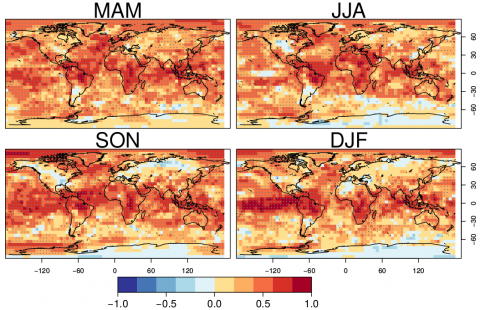A new empirical system based on multiple linear regression for producing probabilistic forecasts of seasonal surface air temperature and precipitation across the globe has been produced1 (see the original publication here). In particular, the global CO2-equivalent concentration is taken as the primary predictor. Large-scale modes of variability in the climate system and local-scale information are subsequently included into the model, based on their physical relationship with the predictand (an analysis of predictand-predictor correlation is performed). By using this regression model, hindcasts are produced for the period 1961-2013 and are validated against observations in terms of deterministic and probabilistic metrics.
The generation of probabilistic forecasts on a global scale along with the use of the long-term trend as a source of skill constitutes a novel approach to empirical forecasting of seasonal climate.
Good skill is found in many regions, particularly for surface air temperature and most notably in parts of Europe during the spring and summer seasons, southern Africa and eastern Australia. For precipitation, skill is generally limited to regions with known El Niño–Southern Oscillation (ENSO) teleconnections (basically the tropics).
This predictive system has been implemented in a quasi-operational framework for providing forecasts for the next 3-month season each month, making them publicly available through the KNMI Climate Explorer along with uncertainty parameters and updated hindcast validation. These forecasts may serve both as a benchmark for dynamical prediction systems and as an independent forecast system to be combined with dynamical output sto produce more robust forecasts for those regions and/or seasons where dynamical models lack of skill.
- Eden, J. M., van Oldenborgh, G. J., Hawkins, E., and Suckling, E. B.: A global empirical system for probabilistic seasonal climate prediction, Geosci. Model Dev., 8, 3947-3973, doi:10.5194/gmd-8-3947-2015, 2015.

